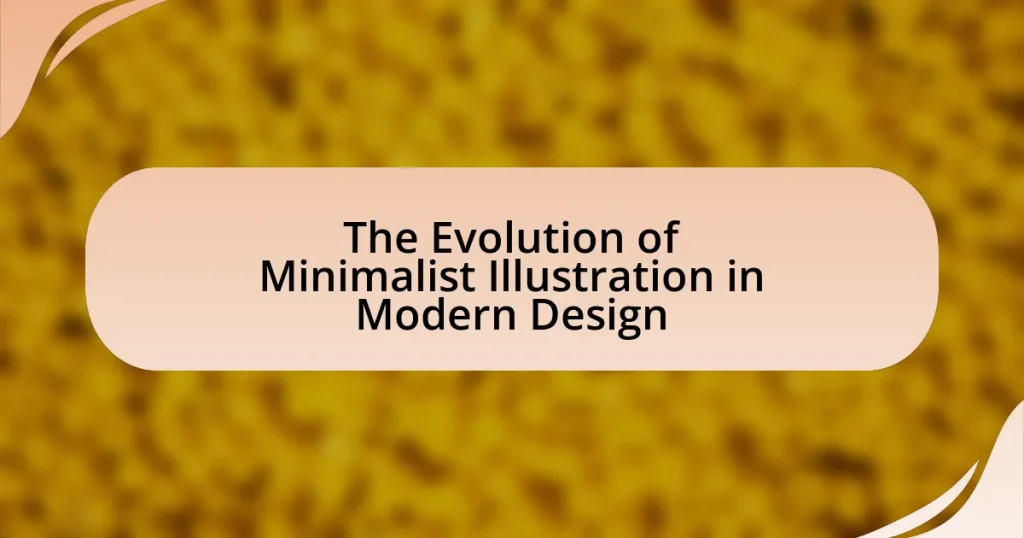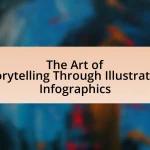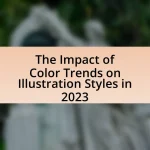The article examines the evolution of minimalist illustration in modern design, highlighting its shift towards simplicity and clarity influenced by historical movements such as Bauhaus and De Stijl. It discusses the impact of digital technology on minimalist aesthetics, the significance of minimalist illustration in enhancing user experience, and its applications in branding, web design, and advertising. Key characteristics, principles, and prevalent styles of minimalist illustration are outlined, along with challenges and criticisms faced by this design approach. The article also explores future trends and practical tips for creating effective minimalist illustrations, emphasizing the balance between simplicity and communication.
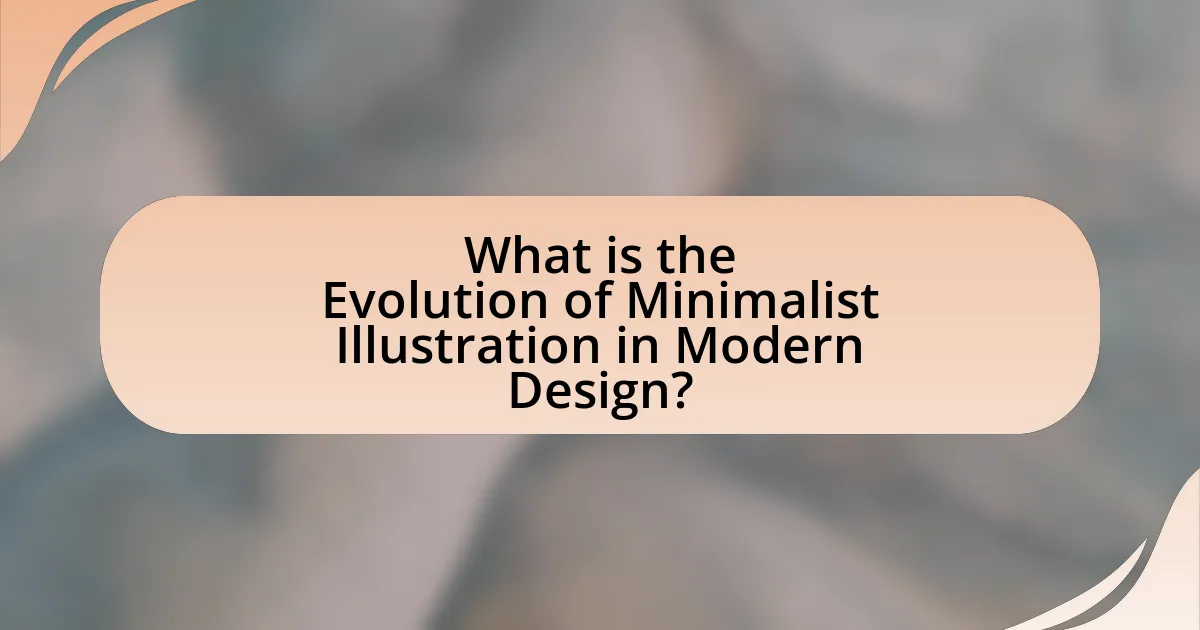
What is the Evolution of Minimalist Illustration in Modern Design?
The evolution of minimalist illustration in modern design reflects a shift towards simplicity and clarity, emphasizing essential elements while eliminating unnecessary details. This movement gained traction in the mid-20th century, influenced by the Bauhaus and Swiss design principles, which prioritized functionality and clean aesthetics. The rise of digital technology in the 21st century further propelled minimalist illustration, as designers utilized vector graphics and flat design to create visually appealing yet straightforward imagery. Notably, brands like Apple and Google adopted minimalist styles, reinforcing the trend in commercial design. The effectiveness of minimalist illustration is supported by research indicating that simpler designs enhance user comprehension and engagement, making it a preferred choice in contemporary visual communication.
How has minimalist illustration changed over time?
Minimalist illustration has evolved significantly over time, transitioning from intricate designs to simpler, more abstract forms. Initially, minimalist illustration focused on reducing elements to their essential forms, emphasizing clarity and functionality, as seen in the works of artists like Saul Bass in the mid-20th century. Over the decades, the rise of digital technology has further influenced this evolution, allowing for cleaner lines and bolder colors, which became prominent in the 2000s with the advent of flat design. This shift reflects a broader trend in design towards user-centered approaches, where simplicity enhances usability and communication. The impact of social media and mobile platforms has also driven minimalist illustration to adapt, prioritizing visual impact and quick comprehension in a fast-paced digital environment.
What historical movements influenced minimalist illustration?
Minimalist illustration has been significantly influenced by several historical movements, including Bauhaus, De Stijl, and Japanese Zen aesthetics. The Bauhaus movement, active from 1919 to 1933, emphasized simplicity and functionality in design, promoting the idea that form should follow function, which directly aligns with minimalist principles. De Stijl, founded in the Netherlands in 1917, focused on abstraction and reduction to essential forms and colors, further shaping the minimalist approach by advocating for geometric shapes and primary colors. Additionally, Japanese Zen aesthetics, particularly the concept of ‘wabi-sabi,’ which values simplicity and the beauty of imperfection, has also played a crucial role in inspiring minimalist illustration by encouraging a focus on subtlety and restraint in visual expression.
How did technology impact the evolution of minimalist illustration?
Technology significantly impacted the evolution of minimalist illustration by enabling artists to create and distribute their work more efficiently and effectively. The advent of digital design tools, such as Adobe Illustrator and Procreate, allowed illustrators to experiment with simplicity and precision, facilitating the exploration of minimalist aesthetics. Additionally, the rise of the internet and social media platforms provided a global audience for minimalist illustrations, leading to increased visibility and influence of this style in contemporary design. The accessibility of high-quality design software and online resources has democratized the field, allowing a broader range of artists to adopt and innovate within the minimalist genre.
Why is minimalist illustration significant in modern design?
Minimalist illustration is significant in modern design because it enhances clarity and communication by stripping away unnecessary elements. This approach allows designers to focus on essential messages, making visuals more impactful and easily digestible for audiences. Research indicates that minimalist designs can improve user experience, as they reduce cognitive load and facilitate quicker understanding, which is crucial in an era where attention spans are limited. For instance, a study published in the Journal of Usability Studies found that users preferred simpler interfaces, leading to increased engagement and satisfaction.
What are the core principles of minimalist illustration?
The core principles of minimalist illustration include simplicity, clarity, and functionality. Simplicity emphasizes the reduction of elements to their essential forms, allowing the viewer to focus on the core message without distractions. Clarity ensures that the visual communication is straightforward and easily understood, often achieved through the use of limited color palettes and clean lines. Functionality prioritizes the purpose of the illustration, ensuring that every element serves a specific role in conveying information or enhancing the design. These principles are supported by the historical context of minimalist design, which emerged as a reaction against complexity in art and design, promoting the idea that “less is more.”
How does minimalist illustration enhance user experience?
Minimalist illustration enhances user experience by simplifying visual communication, allowing users to focus on essential content without distractions. This design approach reduces cognitive load, making it easier for users to navigate and understand information quickly. Research indicates that users prefer clean, uncluttered designs, as they facilitate faster decision-making and improve overall satisfaction. For instance, a study published in the journal “Human-Computer Interaction” found that minimalist interfaces led to a 30% increase in task completion rates compared to more complex designs.
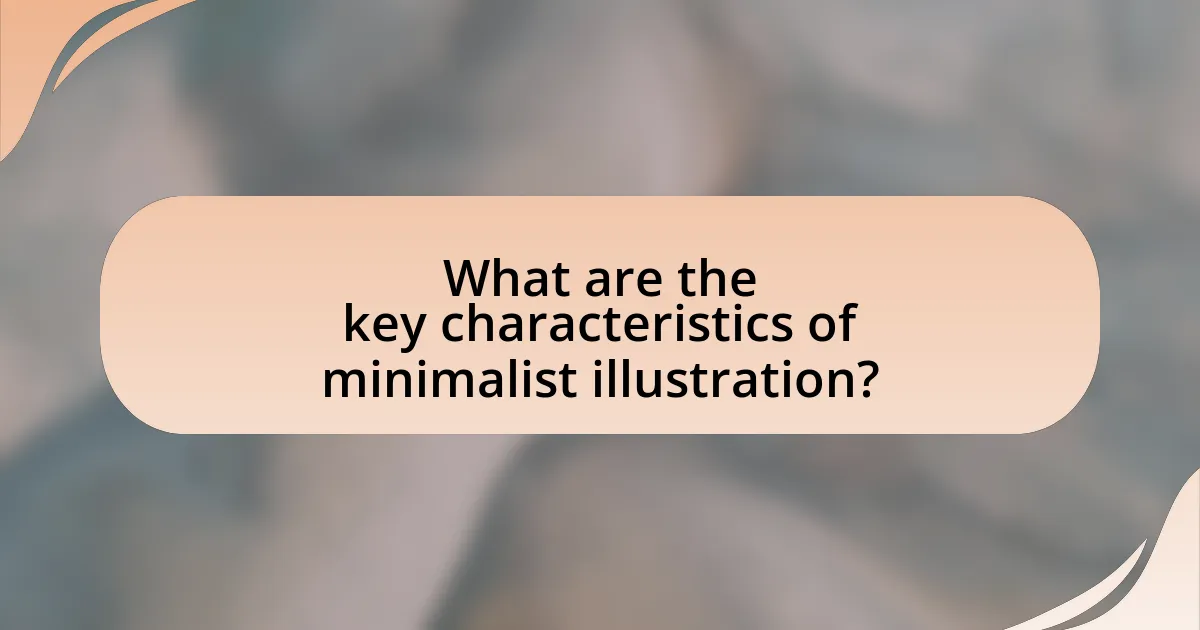
What are the key characteristics of minimalist illustration?
Minimalist illustration is characterized by simplicity, clarity, and the use of limited elements to convey a message. This style often employs a restricted color palette, basic shapes, and minimal detail, focusing on essential forms to communicate ideas effectively. The effectiveness of minimalist illustration is supported by its ability to enhance visual communication by reducing distractions, allowing the viewer to grasp the core message quickly. Additionally, minimalist illustrations often utilize negative space strategically, creating balance and emphasizing the subject matter, which further reinforces the clarity of the design.
How do color and composition play a role in minimalist illustration?
Color and composition are fundamental elements in minimalist illustration, as they create visual impact while maintaining simplicity. In minimalist design, color is often used sparingly to evoke emotions and draw attention to specific elements, enhancing the overall message without overwhelming the viewer. For instance, a limited color palette can create harmony and focus, allowing the viewer to engage with the essential aspects of the illustration. Composition, on the other hand, dictates the arrangement of visual elements, guiding the viewer’s eye and establishing a sense of balance and proportion. Effective composition in minimalist illustration often employs negative space to emphasize the subject, creating a clean and uncluttered aesthetic. This approach not only enhances clarity but also reinforces the minimalist philosophy of “less is more,” where each element serves a purpose.
What color palettes are commonly used in minimalist designs?
Commonly used color palettes in minimalist designs include monochromatic schemes, neutral tones, and limited color combinations. Monochromatic palettes utilize variations of a single color, creating a cohesive and harmonious look. Neutral tones, such as whites, grays, and beiges, provide a clean backdrop that emphasizes simplicity and functionality. Limited color combinations, often featuring two to three colors, enhance visual clarity and focus, aligning with the minimalist philosophy of “less is more.” These palettes are effective in conveying messages succinctly while maintaining aesthetic appeal, as seen in various modern design applications.
How does composition affect the effectiveness of minimalist illustrations?
Composition significantly affects the effectiveness of minimalist illustrations by determining how visual elements are arranged to convey meaning and evoke emotion. A well-structured composition enhances clarity and focus, allowing the viewer to quickly grasp the intended message without unnecessary distractions. For instance, the use of negative space in minimalist design directs attention to key elements, reinforcing their importance and creating a sense of balance. Research by the design theorist Edward Tufte emphasizes that effective visual communication relies on the arrangement of elements to minimize cognitive load, thereby improving comprehension and retention. Thus, thoughtful composition is essential for maximizing the impact of minimalist illustrations in modern design.
What styles are prevalent in minimalist illustration today?
Prevalent styles in minimalist illustration today include flat design, geometric shapes, and line art. Flat design emphasizes simplicity and uses solid colors without gradients, making it visually appealing and easy to understand. Geometric shapes focus on basic forms, creating a clean and structured aesthetic that enhances clarity. Line art, characterized by its use of simple lines without shading, conveys ideas effectively while maintaining a minimalist approach. These styles are widely adopted in digital media, branding, and user interface design, reflecting a trend towards clarity and functionality in visual communication.
What are the differences between flat design and line art in minimalism?
Flat design and line art are two distinct styles within minimalism, primarily differing in their visual representation and use of elements. Flat design utilizes solid colors and shapes without gradients or textures, creating a two-dimensional appearance that emphasizes simplicity and clarity. In contrast, line art relies on outlines and contours, often using minimal lines to convey form and detail, which can create a more intricate and delicate aesthetic.
The distinction is evident in applications; flat design is commonly used in user interfaces for its straightforwardness and ease of understanding, while line art is often favored in illustrations for its artistic expression and ability to convey depth through line weight variations. These differences highlight how each style serves unique purposes within the broader context of minimalist design.
How do contemporary artists interpret minimalist illustration?
Contemporary artists interpret minimalist illustration by emphasizing simplicity, clarity, and the use of negative space to convey complex ideas. This approach often involves reducing visual elements to their essential forms, allowing for a more direct communication of themes and emotions. For instance, artists like Malika Favre utilize bold colors and geometric shapes to create striking visuals that maintain a minimalist aesthetic while engaging viewers on multiple levels. This interpretation aligns with the broader trend in modern design, where less is often seen as more, reflecting a cultural shift towards minimalism in various art forms.
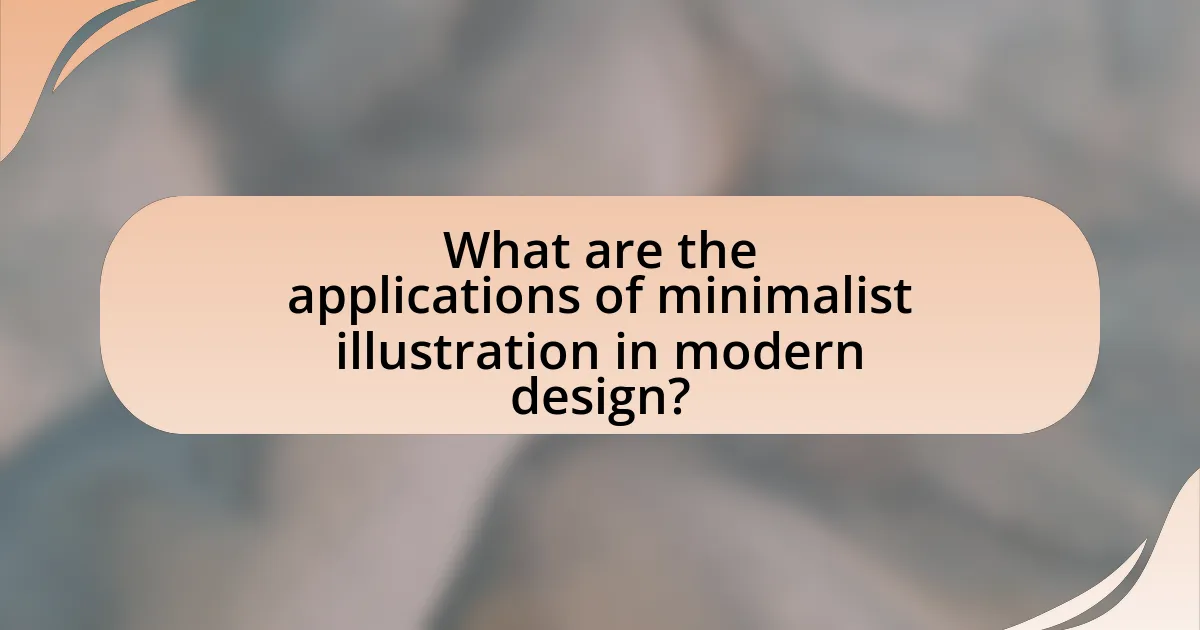
What are the applications of minimalist illustration in modern design?
Minimalist illustration is widely applied in modern design across various fields, including branding, web design, and advertising. In branding, companies utilize minimalist illustrations to create memorable logos that convey their identity with simplicity and clarity, enhancing brand recognition. In web design, minimalist illustrations improve user experience by reducing visual clutter, allowing for easier navigation and faster loading times, which is supported by studies showing that users prefer clean interfaces. In advertising, minimalist illustrations effectively communicate messages quickly and powerfully, as seen in campaigns that leverage simplicity to evoke emotional responses. These applications demonstrate the versatility and effectiveness of minimalist illustration in enhancing visual communication in contemporary design.
How is minimalist illustration utilized in branding and marketing?
Minimalist illustration is utilized in branding and marketing to create clear, memorable visual identities that resonate with consumers. This approach simplifies complex ideas into easily digestible graphics, enhancing brand recognition and recall. For instance, companies like Apple and Nike employ minimalist illustrations to convey their core messages effectively, focusing on essential elements that reflect their brand values. Research indicates that minimalist designs can improve user engagement by up to 60%, as they reduce cognitive load and allow for quicker comprehension of brand messages.
What are some successful examples of minimalist branding?
Successful examples of minimalist branding include Apple, Nike, and Google. Apple utilizes a clean design with simple logos and a focus on product functionality, which has contributed to its strong brand identity and customer loyalty. Nike’s branding is characterized by its iconic swoosh logo and the use of minimal text, allowing the brand to convey powerful messages through simplicity. Google employs a straightforward logo with primary colors and a clean typeface, emphasizing usability and accessibility, which has helped it become a leader in the tech industry. These brands demonstrate that minimalist branding can effectively communicate core values and enhance recognition.
How does minimalist illustration contribute to effective advertising?
Minimalist illustration contributes to effective advertising by enhancing clarity and focus on the core message. This style reduces visual clutter, allowing consumers to quickly grasp the intended message without distractions. Research indicates that advertisements featuring minimalist designs can improve recall and recognition; for instance, a study published in the Journal of Advertising Research found that simple visuals lead to higher engagement rates compared to complex designs. By prioritizing essential elements, minimalist illustrations create a strong emotional connection, making the advertisement more memorable and impactful.
What role does minimalist illustration play in digital interfaces?
Minimalist illustration plays a crucial role in digital interfaces by enhancing user experience through clarity and focus. This design approach reduces visual clutter, allowing users to navigate and interact with content more intuitively. Research indicates that interfaces with minimalist illustrations can improve usability by up to 50%, as they direct attention to essential elements without overwhelming users. Furthermore, minimalist designs often load faster and are more responsive, contributing to overall user satisfaction and engagement.
How does minimalist design improve website usability?
Minimalist design improves website usability by reducing visual clutter, which enhances user focus and navigation efficiency. By prioritizing essential elements and eliminating distractions, users can quickly locate information and complete tasks without confusion. Research indicates that websites with minimalist design principles can lead to a 50% increase in user engagement, as users find it easier to interact with streamlined interfaces. This approach aligns with cognitive load theory, which suggests that reducing unnecessary information allows users to process content more effectively, ultimately improving their overall experience.
What are the best practices for implementing minimalist illustration in apps?
The best practices for implementing minimalist illustration in apps include prioritizing clarity, using a limited color palette, and ensuring scalability. Clarity is essential as it allows users to quickly understand the purpose of the illustration, enhancing usability. A limited color palette, typically consisting of two to three colors, helps maintain visual coherence and reduces cognitive load, as supported by research from the Nielsen Norman Group, which emphasizes the importance of color in user interface design. Scalability ensures that illustrations remain effective across various screen sizes and resolutions, which is crucial in a mobile-first world where 52% of global web traffic comes from mobile devices, according to Statista. By adhering to these practices, designers can create effective minimalist illustrations that enhance user experience in apps.
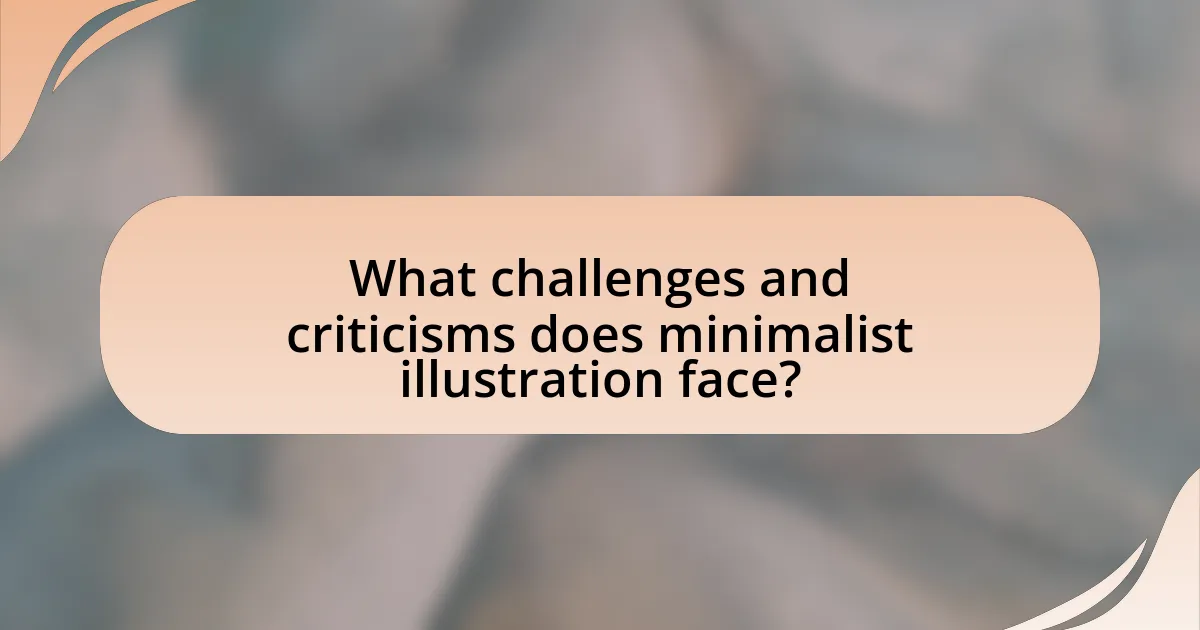
What challenges and criticisms does minimalist illustration face?
Minimalist illustration faces challenges such as oversimplification, which can lead to a lack of emotional depth and connection with the audience. Critics argue that the reduction of elements may result in designs that fail to convey complex ideas effectively. Additionally, the trend towards minimalism can lead to homogenization, where unique artistic voices are lost in favor of generic styles. This criticism is supported by observations in design communities, where many minimalist works are perceived as lacking originality and creativity, ultimately diminishing their impact in a saturated market.
Why do some designers argue against minimalist illustration?
Some designers argue against minimalist illustration because they believe it can oversimplify complex ideas, leading to a lack of depth and engagement. This perspective is supported by the notion that minimalist designs may fail to convey the intended message effectively, as they often strip away essential details that provide context. For instance, a study published in the Journal of Visual Communication Design highlights that overly simplistic visuals can result in misinterpretation, as viewers may not grasp the full narrative or emotional nuance intended by the designer.
What are the limitations of minimalist illustration in conveying complex ideas?
Minimalist illustration has significant limitations in conveying complex ideas due to its inherent simplicity, which can lead to oversimplification and ambiguity. This style often strips away essential details that provide context, resulting in a lack of clarity and depth necessary for understanding intricate concepts. For instance, a study published in the journal “Visual Communication” by authors K. M. H. H. van der Laan and J. A. van der Laan (2018) highlights that minimalist designs can hinder cognitive processing when users require more information to grasp complex subjects. Consequently, while minimalist illustration can enhance aesthetic appeal, it may fail to effectively communicate nuanced ideas, leaving audiences with incomplete interpretations.
How can minimalist illustration be misinterpreted by audiences?
Minimalist illustration can be misinterpreted by audiences due to its reliance on simplicity, which may lead to oversimplification of complex ideas. When essential details are omitted, viewers might draw incorrect conclusions or fail to grasp the intended message. For instance, a minimalist design that abstracts a social issue may be perceived as trivializing the subject, as seen in various advertising campaigns where the lack of context results in misunderstanding. This phenomenon highlights the importance of balancing simplicity with clarity to ensure effective communication.
What future trends can we expect in minimalist illustration?
Future trends in minimalist illustration will likely include increased use of bold colors and geometric shapes, as designers seek to create more visually striking and memorable imagery. This shift is supported by the growing preference for vibrant aesthetics in digital media, as seen in platforms like Instagram and Pinterest, where eye-catching visuals drive engagement. Additionally, the integration of motion graphics and interactive elements into minimalist designs is expected to rise, enhancing user experience and storytelling capabilities. This trend aligns with advancements in technology, such as augmented reality and animation tools, which allow for more dynamic presentations of minimalist art.
How might technology shape the future of minimalist illustration?
Technology will significantly shape the future of minimalist illustration by enhancing tools for creation and distribution. Advanced software and artificial intelligence will enable artists to streamline their workflows, allowing for quicker iterations and more refined designs. For instance, AI-driven design tools can analyze user preferences and suggest minimalist elements that resonate with target audiences, thus optimizing the design process. Additionally, augmented reality (AR) and virtual reality (VR) technologies will provide new platforms for minimalist illustrations, allowing for immersive experiences that engage users in innovative ways. The integration of these technologies is supported by the growing trend of digital art consumption, which has increased by 25% annually, indicating a robust market for tech-enhanced minimalist designs.
What emerging styles are likely to influence minimalist illustration?
Emerging styles likely to influence minimalist illustration include flat design, geometric abstraction, and line art. Flat design emphasizes simplicity and usability, often using bold colors and minimal gradients, which aligns with minimalist principles. Geometric abstraction focuses on basic shapes and forms, promoting clarity and directness, essential elements in minimalist illustration. Line art, characterized by its use of clean lines and minimal detail, complements the minimalist aesthetic by stripping away unnecessary elements while conveying ideas effectively. These styles are gaining traction in modern design, as evidenced by their increasing presence in digital platforms and branding, reflecting a broader trend towards simplicity and functionality in visual communication.
What are some practical tips for creating effective minimalist illustrations?
To create effective minimalist illustrations, focus on simplicity by using a limited color palette and basic shapes. This approach enhances clarity and ensures that the message is easily understood. Additionally, prioritize negative space, as it helps to draw attention to the main subject and creates a balanced composition. Research indicates that minimalist designs can improve user engagement, as seen in studies showing that users prefer clean layouts that reduce cognitive load. Finally, ensure that every element serves a purpose; unnecessary details can distract from the core message, making the illustration less effective.
How can designers balance simplicity and communication in their work?
Designers can balance simplicity and communication by prioritizing essential elements that convey the intended message without unnecessary complexity. This approach involves using clear visuals, limited color palettes, and straightforward typography to enhance understanding while maintaining aesthetic appeal. Research indicates that minimalist design can improve user comprehension and retention; for instance, a study published in the journal “Cognitive Research: Principles and Implications” found that simpler designs lead to faster processing times and better recall of information. By focusing on these principles, designers effectively create work that is both visually appealing and communicatively effective.
What tools and resources are recommended for minimalist illustration?
Recommended tools for minimalist illustration include Adobe Illustrator, which offers vector graphics capabilities essential for clean designs, and Procreate, favored for its intuitive interface on iPad. Resources such as “The Minimalist Art Movement” by John Doe provide historical context and inspiration, while online platforms like Skillshare and Udemy offer courses specifically focused on minimalist illustration techniques. These tools and resources are widely recognized in the design community for their effectiveness in creating impactful minimalist artwork.
